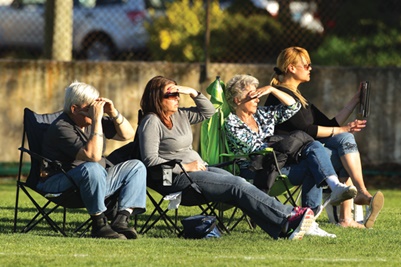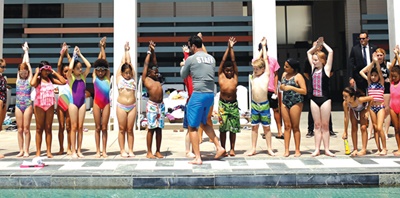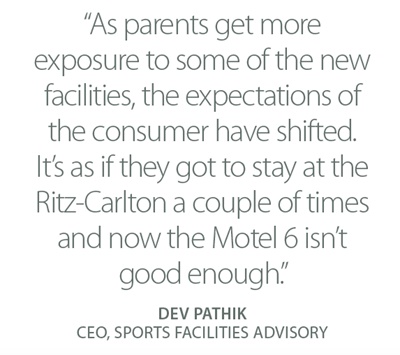When one of his sports commission clients saw a baseball tournament that had been profitable for a dozen years leave for Ripken Baseball’s six-field complex in Pigeon Forge, Tenn., sports tourism consultant Jon Schmieder called the operators to ask why they made the switch.
They explained that while they were happy with the location as a destination, they were looking for a self-contained facility that would allow teams to play all their games in one place, even if the higher cost meant they might lose money.
 |
Families have begun to have higher venue expectations at youth sports events.
GETTY IMAGES |
“They said going back and forth between 17 fields just was not the same experience that they could get if they could put it all in one place,” said Schmieder, founder and CEO of Phoenix-based Huddle Up Group, who previously headed sports commissions in Phoenix, Denver and Tulsa, Okla. “People see the construction of all these mega-facilities and ask what the tipping point is. The answer is I don’t know because the tournament organizers making the buying decisions want more of those.”
Those tournament organizers are responding to the higher expectations of travel sports parents.
“As parents get more exposure to some of the new facilities, the expectations of the consumer have shifted,” said Dev Pathik, CEO of Clearwater, Fla.-based Sports Facilities Advisory consultancy. “It’s as if they got to stay at the Ritz-Carlton a couple of times and now the Motel 6 isn’t good enough.”
Based on trends in the broader travel industry, the arrival of millennials as sports parents will only increase those expectations, presenting a new set of challenges for event and facility operators, not only as end consumers but also as decision-making board members of clubs and leagues.
As travel consumers, millennials have proved more likely to research destinations on the web and seek out advice through their social networks. Their parenting style is likely to be more democratic than those before them, giving children a greater say in what the family does and where it goes. Most importantly, they are the first set of parents to be seen as true digital natives — people who grew up online and reached adulthood with mobile device in hand.
A few years ago, USA Swimming Chief Marketing Officer Matt Farrell crafted a blog post about the ways in which millennial parents could be expected to change the world of youth sports. Fresh off a hotel industry conference about millennials and travel, he heard observation after observation that had implications for those in sports tourism.
“For the last 20-plus years in youth sports we’ve been able to simply open our doors and kids and families came in,” Farrell said. “We’re going to see a dramatic shift where it becomes more about lead generation and marketing and promoting participation. It’s coming at a time that all these other companies are getting involved. But it’s not going to be business as usual — build it and they will come — like it has been. Those days are gone for youth sport.”
Here are four ways executives and consultants who work in youth sports travel are expecting the millennial parent to affect the way they do business:
■ Everything at their fingertips
For parents who take their children to play in a large tournament, the days can be long and the level of uncertainty uncomfortably high. Schedules change based on which teams win or lose. In a tournament played at multiple sites, that means a family knows neither when nor where games will be, or who they will be playing, at any given time over the course of a weekend or more.
The analog solution was a bracket posted at each site and at team hotels, which staffers and volunteers updated as scores were relayed.
In recent years, tournament software has automated that process, moved it online and, increasingly, made it available via mobile devices, with apps that not only keep parents and coaches apprised of the evolving schedule but also give them a social hub to communicate and post photos, as they do in other aspects of their lives.
“Millennials who are now parents have their phones with them constantly and have different expectations than the parents who came before them,” said Lee Zukor, senior vice president for product and user experience for SportsEngine, the NBC-owned youth sports software developer whose clients include the 50-field, 1,000-team Schwan’s USA Cup soccer tournament. “And those expectations are not that every once in a while I see a picture of something that happens at the tournament. Scoring. Getting results. Posting standings. In between games, they want to know everything.
“Where are we going to go? What time is the next game? What teams are playing what teams? Millennials expect to have that all with them.”
For parents who are used to dashing from their cars or vans to check a board for updates during a thunderstorm, the evolution seems a godsend. But for many millennials, it’s likely to be an expectation, the absence of which will make them unlikely to return to the event next year.
“Older parents have the same concerns, but they haven’t relied on their devices in the same way as millennials, so they’re willing to put up with more,” Zukor said. “We think of it as a perk. Millennials don’t think of it as a perk at all.”
Another thing they expect on the tech front: Wi-Fi, which while seemingly ubiquitous is absent at many rec department facilities.
“We’ve had clients who think they have a top facility because their fields are great,” Schmieder said. “We survey U.S. Soccer or US Lacrosse and they say they’re not top anything because they don’t have Wi-Fi or permanent food and beverage. You may have a high opinion of yourself, but the people making the buying decisions see that and say you don’t have the basics.”
■ Lights, camera, action
In much the way that the first generation of players who grew up amid the kid soccer craze of the ’80s and ’90s have become avid fans raising soccer-first kids, the millennials may well nudge their children in a direction that’s slightly different from their predecessors.
Schmieder thinks action sports may see a bump on the youth side as a result of it, pointing to upticks in BMX racing — where kid riders increasingly are joined by their parents — as an indication.
“You’ve got to remember that some of these millennials grew up with different sports in their lives than their parents had,” Schmieder said. “You’ve got guys who raced and then gave it up and joined the work force who have kids who are now old enough to ride. They’re bringing their kids to the racetrack and now they buy a bike and get back into it.”
■ An emphasis on family experiences
One of the takeaways about millennials from the broader travel industry is that they seek out new experiences when they head out on the road. As a result, they may be less likely, as a group, to spend day after day parked in the bleachers or on the sideline at a tournament
 |
Swimming pushes its status as a lifesaving skill.
GETTY IMAGES |
“When you talk about travel sports, many of these parents are forgoing vacations or making this their vacation,” said Lori McMahon Moore, general manager of Rocky Top Sports World, a Gatlinburg, Tenn., facility that can configure for up to 13 youth soccer fields and 10 indoor basketball courts or 17 volleyball courts. “So we try to do all we can to help them create memories while they’re here. Some of that is going to be around the sporting event. But we are also fortunate in our market to have a variety of things for them to do.”
Like many pro and college sports facilities, Rocky Top has several signature spots on its campus designed to help families and teams capture memories of their trip with selfies and team photos. All of them prominently display the Rocky Top Sports World logo. The facility also has a mascot that frequently ends up in photos that players and families share.
At a recent large girls basketball tournament, the mascot created an especially popular photo op.
“We had 100 cameras on the bear because he was laying in the middle of the floor with the girls piling on top of him,” McMahon Moore said. “It was just one of those memorable moments. They’re not going to let you do that with Mickey Mouse.”
■ Paying it forward
The same cause-driven approach that made Toms Shoes’ “One for One” campaign popular among millennials could resonate for some youth sports organizations.
“We know [millennials] like to be part of organizations that promote a cause or that they see as giving back,” Farrell said.






